
Know before you buy: Compressed air tank for paintball

The compressed air tank, commonly referred to as a high pressure air tank (HPA), is the power plant of the modern paintball marker. In today’s post we’ll discuss the terminology you’ll need to know to purchase the right tank. Along the way we’ll also go over some tips on maintenance, safety, and usage to get the most out of your purchase. This information applies for every major paintball market, not just those playing or at Urban War Zone Paintball in Houston, Tx.
Estimated reading time: 8.5 minutes
Design and Engineering
Compressed air paintball tanks are composed of two main parts, a high-strength bottle and a mechanical regulator. Bottles and regulators are generally sold as a complete unit, called an “air system,” but the components can be disconnected from each other for maintenance, upgrades, or airline travel.
All bottles must be disassembled for travel and packed in your carry-on luggage. No units may be packed in your checked luggage and assembled units are strictly forbidden by the TSA as of 2023.
Do not disconnect the regulator from the bottle without proper tools and training.
High Pressure Bottle
The bottle is the largest part of an air system. Its primary purpose is to safely hold high pressure air inside the cylinder without leaking or bursting. Although bottles may be branded with different colors, logos, or graphics, almost all tanks are made by Luxfer Gas Cylinders. The United States Department of Transportation (US-DOT) heavily regulates high pressure cylinders and bottle performance is the same regardless of brand.
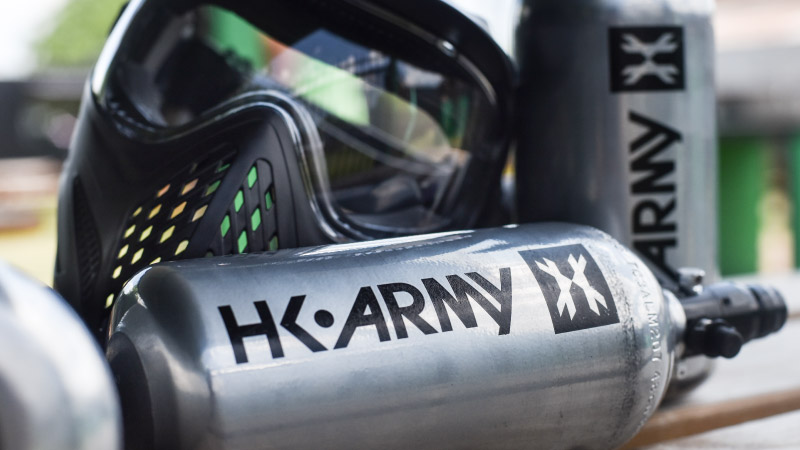
The capacity of a bottle is determined by the combination of 2 factors, internal volume and pressure rating. The higher the capacity, the more shots you can fire before needing a refill.
Internal Volume
Internal volume is measured in cubic inches, abbreviated as cu or ci. Bottles range in size from 13 cu on the low end to 90 cu or more on the high end. More internal volume means more shot capacity, but extra capacity comes with the trade off of more weight. Larger bottles are significantly heavier and the extra capacity is often unnecessary. The vast majority of players will choose an internal volume between 48 cu and 68 cu.
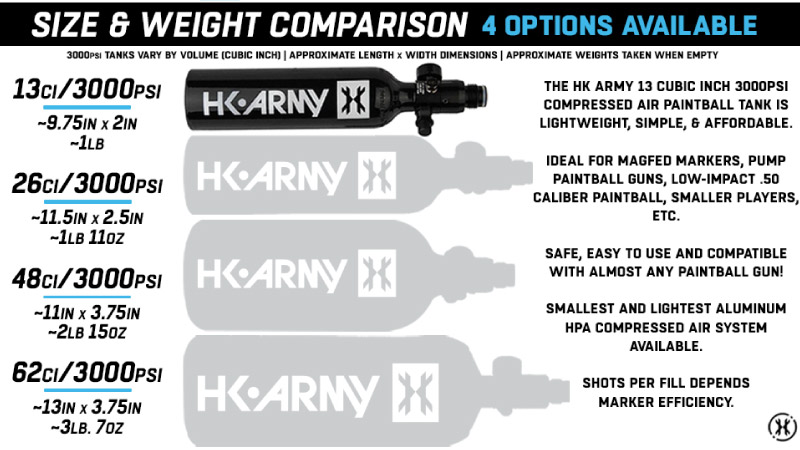
“If you value speed and agility, go small. If you want volume and endurance, go big.”
Pressure rating
Bottles are made in 2 pressure variants. We’ll talk more about pressure ratings below, but for now, what you need to know is that more pressure means more shots for the same size bottle. A 48 cubic inch bottle capable of holding 4500 psi will hold 50% more air than a 48 cubic inch bottle at 3000 psi.
Pressure Regulator
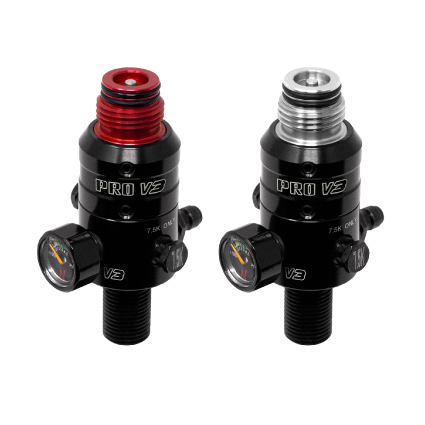
It would be dangerous to release the extreme air pressure in a bottle directly into a paintball marker. The regulator reduces bottle output pressure to a safe usable marker input pressure. Entry and mid level paintball markers typically require 800 psi input, but high end paintball markers often require lower input pressures, 450 psi, 550 psi, and 650 psi being the most common.
Preset & Adjustable
Regulators are sold in two flavors, preset and adjustable. Preset regulators are set by the factory and cannot be adjusted by the end user. Adjustable regulators, on the other hand, can be adjusted by the player to match the requirements of specific paintball markers.
Compatibility
Not every paintball marker works with every preset output pressure. Very high end markers, in particular, may have different output pressure specifications. When purchasing a new compressed air tank it’s important to know what the regulator output pressure is and match it to the required input pressure of your particular marker. Consult the manual before purchasing an air system to be sure you know the correct input pressure to buy.
Players who own multiple high end markers with different input pressure requirements might consider purchasing a single air system with an adjustable regulator rather than a preset air system for each marker they own.
Manufacturing Materials
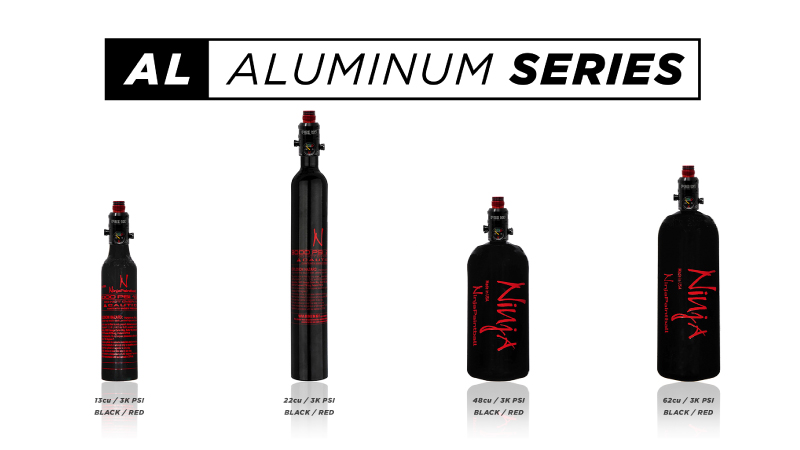
Aluminum
Sometimes called a “steel” or “steely,” the core of the bottle is actually a special grade of aluminum known as 6061-T6. Commonly used in the manufacturing of aircraft parts, bicycle frames and yachts, 6061-T6 is lightweight, durable and resistant to corrosion or fatigue.
Aluminum bottles are affordable, but hold a maximum pressure of 3000 psi and come in a limited number of internal volume sizes, most commonly 48 cubic inches.
Carbon Fiber Composite
Carbon fiber composite bottles offer several distinct advantages over standard aluminum bottles.
- High pressure capability
- Less aluminum in the bottle core
- Failures result in leaks before bursts
- Corrosion resistant
- Wide range of graphics, styles, and colors
- Cost effective recertification
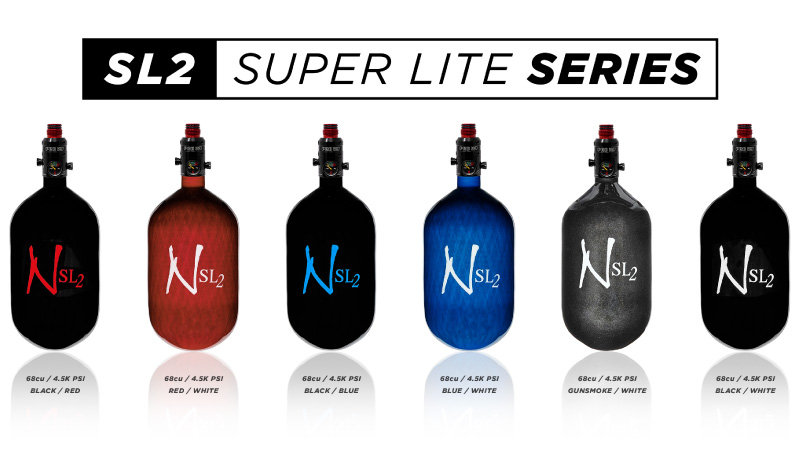
Functionally, carbon fiber bottles are lighter, stronger and have a higher pressure rating than standard aluminum bottles. Stylistically, carbon fiber bottles are much better looking and there is a graphic style or color that matches any color scheme you could dream up.
Total Cost of Purchase
Composite bottles are far superior, but you pay 3 to 5 times more for the performance and style. Composite bottles also expire after 15 years regardless of condition. This may seem like a point in favor of aluminum bottles, which do not expire, but the cost of recertification is about the same as purchasing a new bottle.
Total cost of buying an aluminum tank
To calculate the total cost of ownership of an aluminum tank, we’ll assume a new tank once every 5 years.
- First purchase: ~$69
- Second purchase: $69
- Total after 10 years: $140
Total cost of buying a carbon fiber composit tank
To calculate the total cost of ownership of a composite air system, we’ll assume a new tank and 1 recertification after 5 years.
- First purchase: ~$175
- Recertification: $50
- Total after 10 years: $225
While the upfront cost of a composite tank is significant, for less than $10 per year you can enjoy a stylish air system with higher performance and better safety standards. If it’s in the budget, buy a carbon fiber tank.
Common tank sizes
Aluminum sizes
A standard aluminum paintball tank holds 3000 psi and can be found in 9 cu, 13 cu, 48 cu, and 68 cu. 48 cu is the most common size.
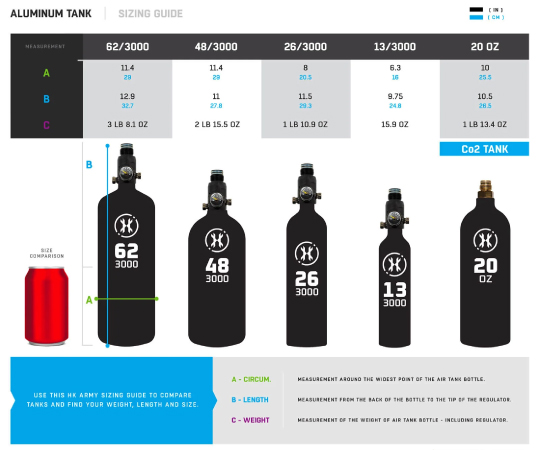
Carbon fiber sizes
A carbon fiber paintball tank holds 4500 psi and can be found in 13 cu, 48 cu, 50 cu, 68 cu, and 90 cu. 68 cu is the most common size.
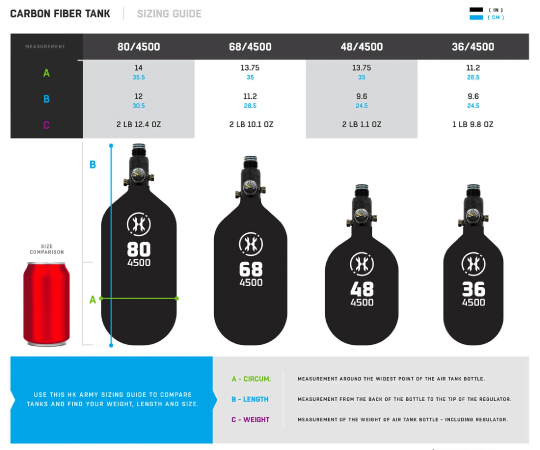
Bottle & Regulator Maintenance
Warning: Air system maintenance should not be attempted without proper training - which this post does not attempt to do. Injury, death or disfigurement may occur if you attempt maintenance or repair without proper training.
The bottle does not need regular maintenance but it should be inspected before each use for cracks, dents, gouges or fire damage. Send the tank for recertification if there is any doubt that the tank is in perfect working order. Do not risk your life filling a tank that may fail catastrophically.
Regulator threads
The regulator has large well defined threads that guide the tank into your paintball marker. These threads are easily damaged if the tank is dropped or roughly transported. Ninja paintball is one of several companies selling tank accessories that will protect the threads while the tank is not mounted on the marker.
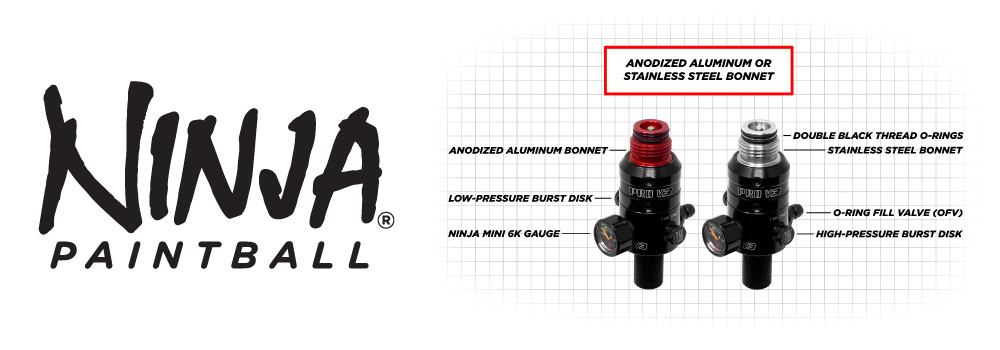
If your marker does not have an air-source-adapter (ASA) with a quick release there’s a very good chance you will eventually damage the threads of the regulator when you remove the air system while it’s still under pressure. Safely degas the bottle before removing the tank to avoid damaging the threads.
Tank O-Rings
Regulators will have 1 or 2 polyurethane o-rings that seal the tank to the marker and prevent gas from leaking out of the ASA. These o-rings do not need lubrication, but they should be wiped clean and inspected for cuts, tears, or shredding that indicate they are about to fail. Replacement is quick and easy.
Internal Lubrication
We will cover regulator removal, disassembly and maintenance in another post. For now, it’s enough to know that regulators do need to be kept clean and occasionally lubricated with lubricants that meet specifications for high pressure applications. Threads can be wiped clean and exterior sealing o-rings are cheap and easy to replace when they harden and eventually break.
Never, under any circumstances, use liquid gun oil or any other type of lubricant on any part of the bottle or regulator that is not specifically rated for high pressure applications. Improper lubrication can result in explosive failure of the bottle.
What is compressed air?
Compressed air is regular air that has been forced into a small container, similar to SCUBA tanks. Compressed air for paintball tanks should not be used as breathing air because the compression process can introduce chemicals that are harmful to humans. Filtering the air for human breathing requires special filters that are expensive. Most paintball parks do not use these special filters and players should not attempt to breathe from a paintball bottle.
Can I refill my tank at home?
The short answer is no. Most industrial compressors built for construction, automotive and industrial paint applications deliver high volumes of air at relatively low pressure. A typical pancake compressor at Home Depot, for example, has a maximum pressure output of 150 psi. Some specialized compressors may reach 250 - 500 psi.
Paintball compressors, on the other hand, are built to deliver extreme pressures standard compressors will never reach. The compressor at Urban War Zone, for example, can deliver constant pressure at 5000 psi all day without overheating.
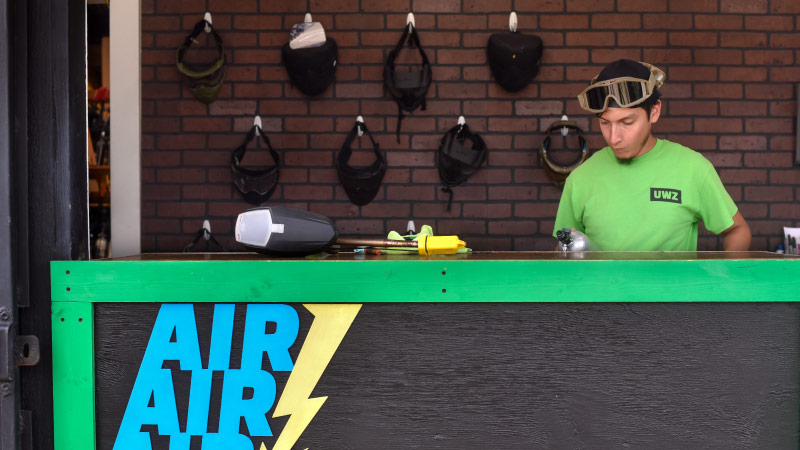
How long will the bottle last?
Bottles are subjected to repeated pressure cycles that weaken the container over time. The DOT specifies that every bottle has a stamp or sticker indicating the month and date it was manufactured.
The tank must then be inspected and certified for use every 5 years until it reaches the maximum allowable age, at which point it is retired from service. Paintball carries enough risk, never attempt to fill a bottle that requires recertification.
Installing and removing your tank
Attaching an air system to a marker is quick and easy. Be gentle, air systems should mount easily to the marker. Never use force!
Markers with quick connect ASA
- Ensure that the threads on the regulator are clean and free of damage.
- Align the threads to the ASA and gently twist the bottle until the regulator catches and threads onto the marker. Be gentle and never twist with force.
- Continue turning gently until the bottle stops rotating.
- Engage the air supply with the quick connect ASA.
Markers without quick connect ASA
- Ensure that the threads on the regulator are clean and free of damage.
- Ensure the tank is pressure free. Installing pressurized bottles will cause damage.
- Align the threads to the ASA and gently twist the bottle until the regulator catches and threads onto the marker. Be gentle and never twist with force.
- Continue turning gently until the bottle stops rotating.
- The air system is ready to be filled.
Removing the tank is as simple as disconnecting the air supply on the ASA if you have a quick disconnect and turning the tank counter clockwise.
If you do not have a quick disconnect you should safely discharge the bottle. Removing a pressurized bottle from a paintball marker without a quick disconnect is a sure way to ruin the threads on the regulator.
Filling a compressed air tank
Compressed air tanks are filled through a small ⅛ inch nipple located on the side of the regulator. The air system does not need to be removed and can be filled while it is still mounted on your marker. This is a big advantage over old-school CO2 tanks which are filled through the top of the tank. Players using CO2 for paintball have to remove it from their marker every time they need to refill.
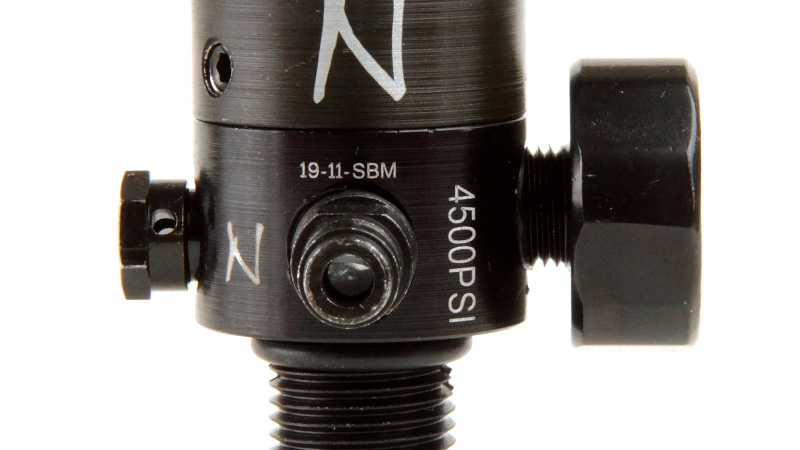
Compressed air tanks can be filled at any reputable paintball field. Some local scuba shops may also be able to fill them as well, but you may want to call ahead to make sure they have the correct adapters and some experience filling paintball tanks.
Many paintball fields allow self-service air refills. We will go over how to use an air station in another post, but if you’re unsure how to refill your air system, ask for help. Paintball field attendants should be eager to give you some quick training and it’s easy to do.
Conclusion
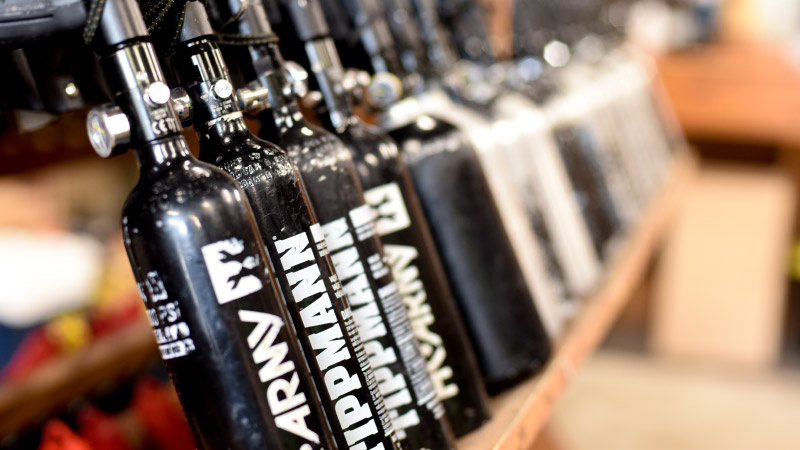
There are many HPA paintball tanks on the market today and you can rest assured that all of them will be high quality because the US-DOT regulates tank specifications.
Now that you’re armed with the terminology sellers use to market their tanks, you can choose the air system that fits your budget and style.
Buying a compressed air tank is a big commitment. If you'd like to save a few dollars, you might consider a CO2 tank for paintball. You can read up about those here: 5 things to consider before buying a CO2 tank
